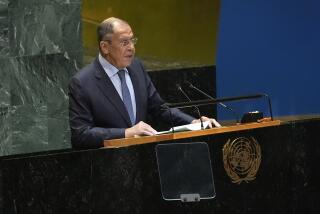NEWS ANALYSIS : Soviet Proposal Challenges U.S. to Go Further
- Share via
WASHINGTON — In the gathering rush toward drastically reduced nuclear arsenals, the Soviet Union on Saturday matched President Bush’s radical cuts in short-range weapons and then went several steps further.
Soon afterward, the White House issued a statement saying that President Bush “responded positively to President Gorbachev’s steps in picking up on the President’s initiative.”
Gorbachev telephoned Bush before announcing the new moves, and the two men spoke for about 20 minutes, said spokesman Doug Davidson. The Soviet ideas will be explored in detail this week in Moscow with a U.S. team which arrived there Friday to explain the Bush proposal, Davidson said.
The Administration withheld detailed comment on the proposal, including a bid by Gorbachev for another arms-control meeting.
The most significant element of Gorbachev’s announcement was a suggestion that much deeper reductions be made in long-range nuclear weaponry than the United States has thus far considered.
In his dramatic arms-control overture a week ago, President Bush called for stepping up the schedule of cuts in long-range nuclear warheads that were set out in the recently signed superpower strategic arms treaty. But he did not propose making further reductions below the 6,000-weapon ceiling.
Saturday, Gorbachev boldly pledged unilaterally to slash the Soviet arsenal 1,000 below that level. He also called for talks to slash this START Treaty ceiling fully in half, to 3,000 strategic weapons on each side, and for a new superpower arms-control summit.
However, arms-control experts said the Administration may find cause for both enthusiam and qualms in the Soviet move.
The Administration may find it hard not to adopt the Soviet lead on deeper long-range cuts, particularly if the 1,000 extra Soviet warheads involved would come from missiles in the Ukraine and Kazakhstan. One of the chief purposes of the Bush overture was to get Moscow to withdraw or eliminate all nuclear weapons, tactical and strategic, from non-Russian republics so they can be kept under closer control.
Also, the Administration would be reluctant to appear disinterested in continuing the momentum toward smaller nuclear stockpiles.
However, deeper reductions might also cut into core weapons systems that, at this point, the United States has planned to protect.
For example, the Administration has decided to retain a force of 18 ballistic-missile submarines for maximum security and can remove only a certain number of warheads from the missiles in those submarines.
“It would be hard to go down another 1,000 warheads” unless some major adjustments were made, said one official.
More broadly, though, experts said the Administration could not help but be pleased with the overall scope of the Soviet response, particularly Gorbachev’s agreement to cut the short-range weapons that were a prime element of Bush’s initiative.
“We seemed to have gotten the right response from Gorbachev on tactical nukes, although he has raised the ante somewhat,” said Jack Mendelsohn, deputy director of the private Arms Control Assn.
“And it was clever of the Soviets to come back calling for lower START ceilings.”
Gorbachev took three other actions, all considered predictable in the circumstances, in attempting to use Bush’s ideas to promote Soviet interests:
* He called for eliminating the final category of tactical nuclear weapons which Bush had ignored--air-launched bombs and missiles. But North Atlantic Treaty Organization officials believe that such aircraft-delivered weapons are needed in Europe. Although the stockpile of these weapons is expected to be almost halved (from 1,500 to between 500 and 1,000), the Soviet offer to eliminate them may be a non-starter.
* He proposed eliminating all tactical nuclear weapons based on ships and in submarines. This would go beyond Bush’s plan, which is to withdraw and eliminate nuclear torpedoes and depth charges, but to only withdraw, and store, sea-launched cruise missiles and bombs. Again, this appears to be a non-starter in view of the value the U.S. Navy attaches to these weapons.
* And finally, Gorbachev declared a one-year unilateral nuclear test ban, hoping other nations will follow suit. He did it before, in 1987-88, without getting any takers.
Gorbachev is really offering nothing in this respect, since the two Soviet underground test sites, at Semipalatinsk in Kazakhstan and Novaya Zemlaya in the Russian Arctic, are both closed because of environmental objections of local residents. (Only underground testing is permitted by both nations under various treaties.)
More to Read
Sign up for Essential California
The most important California stories and recommendations in your inbox every morning.
You may occasionally receive promotional content from the Los Angeles Times.












